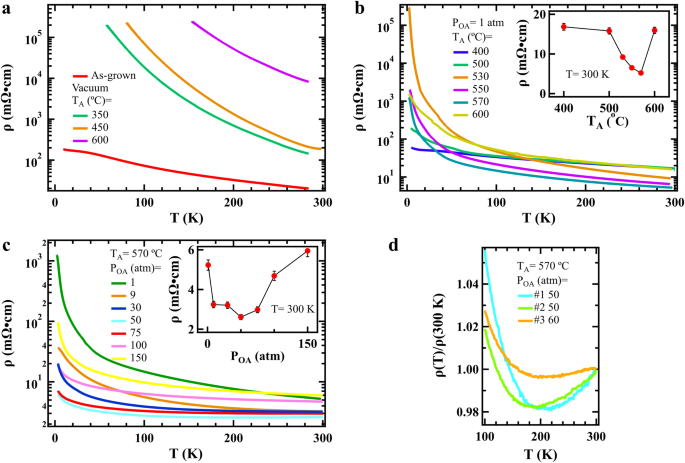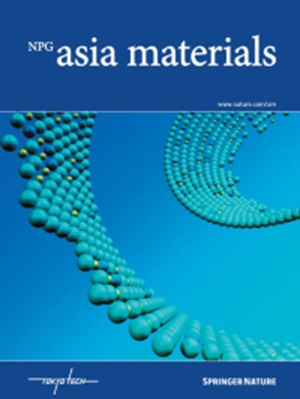Realizing metallicity in Sr2IrO4 thin films by high-pressure oxygen annealing
IF 8.3
2区 材料科学
Q1 MATERIALS SCIENCE, MULTIDISCIPLINARY
引用次数: 0
Abstract
Perovskite iridates are a promising material platform for hosting unconventional superconductivity. Transport measurements of Sr2IrO4 thin-film field-effect transistors are expected to provide irrefutable evidence for the existence of superconductivity. However, these experiments have revealed a remarkably robust insulating state over wide electron and hole doping ranges; this finding is in contrast to the case of the bulk material, in which metallicity appears upon moderate electron doping by substituting cations in place of Sr. The nature of this robust insulating state and whether any metallic state can be realized in the Sr2IrO4 thin film are two remaining challenges that preclude further progress in the search for superconductivity in this system. Here, we show that this insulating state is enhanced in Sr2IrO4 thin films by thermal annealing under vacuum conditions, while it can be destroyed upon annealing in an oxygen atmosphere within restricted ranges of oxygen pressure, annealing temperature and ion substitution levels. The resulting films exhibit metallic transport behavior near room temperature and a metal–insulator crossover at ~200 K. Our results point to the potentially important roles of the oxygen vacancies at different atomic sites in the formation of the robust insulating state and the new metallic state and to their interplay in the Sr2IrO4 thin film. This finding opens new possibilities in the search for unconventional superconductivity by further tailoring the as-found metallic state in properly oxygen-annealed Sr2IrO4 thin films. Despite enormous efforts by many research groups, Sr2IrO4 was found to stay remarkably insulating in thin film form. Now, a high-pressure oxygen annealing treatment on the Sr2IrO4 thin film realized the long-sought metallicity for the first time. An emerging transport phase diagram was deduced from the experiment that features an interplay between two states: the robust insulating state, which is likely dominated by the defect scattering effect of planar oxygen vacancies O(2), and the new metallic state, which likely reflects an intrinsic bulk-like property of the IrO2 planes with effective electron doping due to apical oxygen vacancies O(1).


用高压氧退火实现Sr_2IrO_4薄膜的金属性
钙钛矿铱酸盐是一种很有前途的承载非常规超导性的材料平台。Sr2IrO4薄膜场效应晶体管的输运测量有望为超导性的存在提供无可辩驳的证据。然而,这些实验揭示了在较宽的电子和空穴掺杂范围内具有非常稳健的绝缘状态;这一发现与块状材料的情况相反,在块状材料中,金属性是通过用阳离子取代锶而适度的电子掺杂而出现的。这种坚固的绝缘状态的性质以及是否可以在Sr2IrO4薄膜中实现任何金属状态是阻碍该系统中超导性研究进一步进展的两个挑战。在这里,我们发现Sr2IrO4薄膜在真空条件下的热退火可以增强这种绝缘状态,而在氧气气氛中,在氧气压力、退火温度和离子取代水平的限制范围内退火可以破坏这种绝缘状态。所得薄膜在室温附近表现出金属输运行为,在~ 200k时表现出金属绝缘体交叉。我们的研究结果指出了不同原子位置上的氧空位在形成坚固的绝缘状态和新的金属状态中的潜在重要作用,以及它们在Sr2IrO4薄膜中的相互作用。这一发现为进一步在适当的氧退火的Sr2IrO4薄膜中裁剪已发现的金属态开辟了寻找非常规超导性的新可能性。尽管许多研究小组付出了巨大的努力,但人们发现Sr2IrO4在薄膜形式下仍然保持着显著的绝缘性。现在,对Sr2IrO4薄膜进行高压氧退火处理,首次实现了长期追求的金属丰度。从实验中推断出一个新出现的输运相图,其特征是两种状态之间的相互作用:稳健的绝缘状态,可能是由平面氧空位O(2)的缺陷散射效应主导的;新的金属状态,可能反映了由于顶端氧空位O(1)而有效电子掺杂的IrO2平面的固有块状性质。
本文章由计算机程序翻译,如有差异,请以英文原文为准。
求助全文
约1分钟内获得全文
求助全文
来源期刊

Npg Asia Materials
MATERIALS SCIENCE, MULTIDISCIPLINARY-
CiteScore
15.40
自引率
1.00%
发文量
87
审稿时长
2 months
期刊介绍:
NPG Asia Materials is an open access, international journal that publishes peer-reviewed review and primary research articles in the field of materials sciences. The journal has a global outlook and reach, with a base in the Asia-Pacific region to reflect the significant and growing output of materials research from this area. The target audience for NPG Asia Materials is scientists and researchers involved in materials research, covering a wide range of disciplines including physical and chemical sciences, biotechnology, and nanotechnology. The journal particularly welcomes high-quality articles from rapidly advancing areas that bridge the gap between materials science and engineering, as well as the classical disciplines of physics, chemistry, and biology. NPG Asia Materials is abstracted/indexed in Journal Citation Reports/Science Edition Web of Knowledge, Google Scholar, Chemical Abstract Services, Scopus, Ulrichsweb (ProQuest), and Scirus.
 求助内容:
求助内容: 应助结果提醒方式:
应助结果提醒方式:


